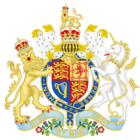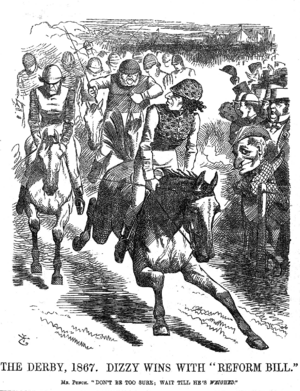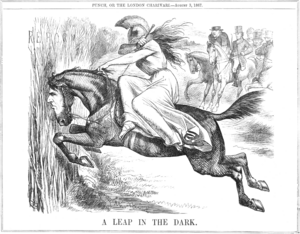Reform Act 1867 facts for kids

|
|
| Long title | An Act further to amend the Laws relating to the Representation of the People in England and Wales. |
|---|---|
| Citation | 30 & 31 Vict. c. 102 |
| Territorial extent | United Kingdom |
| Dates | |
| Royal assent | 15 August 1867 |
| Other legislation | |
| Relates to | Reform Act 1884 |
| Text of statute as originally enacted | |
The Representation of the People Act 1867, also known as the Reform Act 1867 or the Second Reform Act, was an important law passed in Britain. It gave many working-class men in England and Wales the right to vote for the first time. This law started to take effect in stages and was fully in place by January 1, 1869.
Before this Act, only about one million out of seven million adult men in England and Wales could vote. The new law immediately doubled that number. By the end of 1868, almost all male heads of households could vote. This was a big change for how people participated in choosing their leaders.
The Conservative Party, led by Benjamin Disraeli, hoped this law would make people vote for them. However, they actually lost the election in 1868 after the Act was passed.
Contents
Why Was Reform Needed?
For many years after the first big voting reform in 1832, politicians didn't want to change the voting rules much. Groups like the Chartists had asked for more rights, but their ideas were not accepted at first.
After 1848, people started to think more about who should be allowed to vote. In 1860, Lord John Russell tried to pass a new reform bill. But the Prime Minister, Lord Palmerston, didn't think more changes were needed.
The end of the American Civil War in 1865 encouraged people in Britain to demand more democracy. Many felt that more people should have a say in how the country was run. Some important thinkers like John Stuart Mill supported these ideas. They argued that hardworking and responsible men deserved the right to vote.
When Lord Palmerston died in 1865, the path for reform opened up. In 1866, Lord Russell, now Prime Minister, introduced a new bill. This bill was careful and only aimed to give "respectable" working men the vote. It tried to exclude those seen as "lazy or criminal" poor.
However, this bill caused a split in the Liberal Party. Benjamin Disraeli helped cause this split. Some Liberals, called the Adullamites, were against the reform. Others supported the government's plan. Because of this disagreement, the bill was defeated, and Russell's government resigned.
How the Act Came to Be
The Conservative Party then formed a new government in June 1866. Lord Derby became Prime Minister, and Benjamin Disraeli was in charge of the country's money. The Liberal Party was divided, so the Conservatives saw a chance to become a stronger party.
Even though Disraeli had stopped the Liberal reform bill, he introduced his own reform bill in February 1867. By this time, many people in the country really wanted changes to how the House of Commons worked. Large meetings and protests, like the 'Hyde Park riots', showed that people felt skilled working-class men deserved the right to vote.
The Reform League, a group pushing for everyone to have the right to vote, became very active. They organized huge protests in cities like Manchester and Glasgow. In May 1867, the government tried to ban a protest in Hyde Park, London. But so many people showed up that the government didn't dare to stop them. The Home Secretary, Spencer Walpole, had to resign.
Because of the risk of more protests, the government quickly added changes to the bill. These changes gave even more people the right to vote than anyone expected. Disraeli seemed to accept most of the new ideas, as long as they didn't come from William Gladstone, a leading Liberal.
The bill ended up giving most men in cities the right to vote. This included men who paid local taxes directly and those who paid more than £10 in rent each year. There were also "fancy franchises" for graduates, professionals, and those with savings, which Conservatives hoped would balance the new voters.
Gladstone, however, criticized the bill. His debates with Disraeli made the bill even more radical. Disraeli had gone further than Gladstone's bill, which had been defeated the year before.
Disraeli convinced his party to vote for the bill. He believed the new voters would be thankful and vote Conservative in the next election. But this didn't happen. In 1868, the Conservatives lost the first general election where the newly enfranchised voters participated.
The Act helped the more radical part of the Liberal Party grow and helped Gladstone win the election. Many other laws were passed later to fix voting boundaries.
What the Act Changed
Who Lost Their Vote?
The Act removed the right to elect Members of Parliament (MPs) from some towns, often because of corruption.
- Four towns lost all their MPs: Totnes, Great Yarmouth, Lancaster, and Reigate.
- Seven more towns lost their MPs the next year: Arundel, Ashburton, Dartmouth, Honiton, Lyme Regis, Thetford, and Wells.
The Act also reduced the number of MPs for many other towns. For example, 35 towns that used to elect two MPs could now only elect one.
Who Gained the Right to Vote?
The Act created new single-member seats in nine towns:
- Burnley, Darlington, Dewsbury, Gravesend, Hartlepool, Middlesbrough, Stalybridge, Stockton, and Wednesbury.
Two new towns, Chelsea and Hackney, were given two MPs each.
Some larger cities also gained more MPs:
- Salford and Merthyr Tydfil went from one MP to two.
- Birmingham, Leeds, Liverpool, and Manchester went from two MPs to three.
Other changes included:
- The West Riding of Yorkshire was divided into three areas, each electing two MPs.
- Several counties like Cheshire and Kent were divided into three areas instead of two, each electing two MPs.
- The University of London was given one seat in Parliament.
- MPs no longer had to seek re-election if they changed government jobs.
Changes for Scotland and Ireland
Separate laws were passed in 1868 to make similar voting reforms in Scotland and Ireland.
In Scotland, five existing areas gained more MPs, and three new areas were created. This meant Scotland gained seven more MPs overall. To keep the total number of MPs in the House of Commons the same, seven English towns (mentioned above) lost their MPs.
The number of MPs for Ireland did not change.
What Happened After the Act?
Unexpected Results
The Act led to some big changes:
- Political parties started spending a lot more money and organizing more at local and national levels. Politicians had to connect with many more voters.
- Even though more people could vote, the House of Commons actually became more controlled by the upper classes. This was because campaigning became very expensive, and only wealthy people could afford it.
- The Liberal Party worried that a socialist party might gain power from the working-class vote. So, they started to adopt more left-leaning ideas.
The Representation of the People Act 1867 was a huge step in British democracy. It showed that public opinion and protests could lead to major changes in how the country was governed.
Learn More
- Ballot Act 1872
- Reform Acts
- Representation of the People Act
- Representation of the People Act 1884 (the Third Reform Act)
- Representation of the People Act 1918 (the Fourth Reform Act)
- Redistribution of Seats Act 1885
- Benjamin Disraeli
- William Ewart Gladstone
- Chartism



